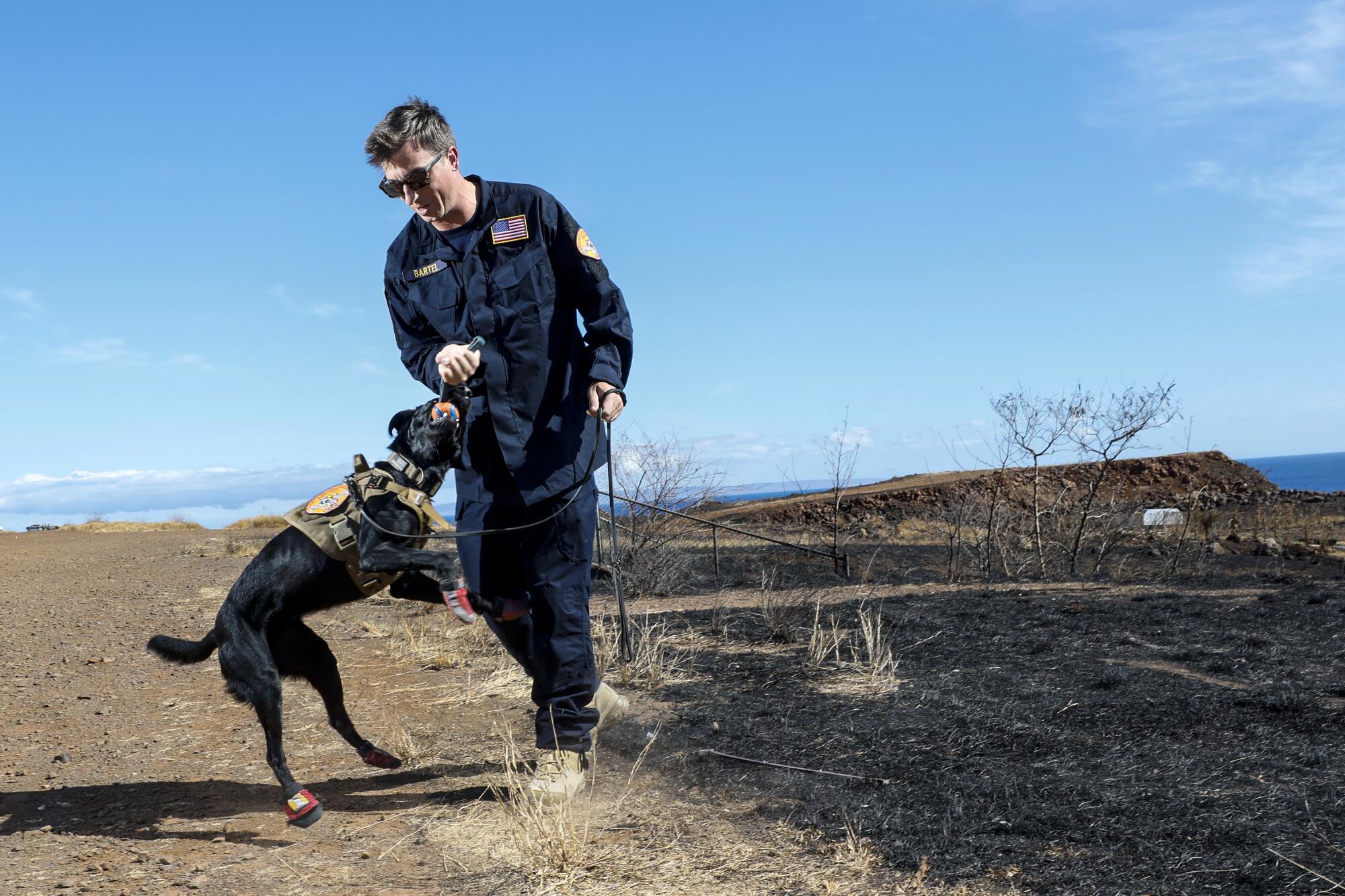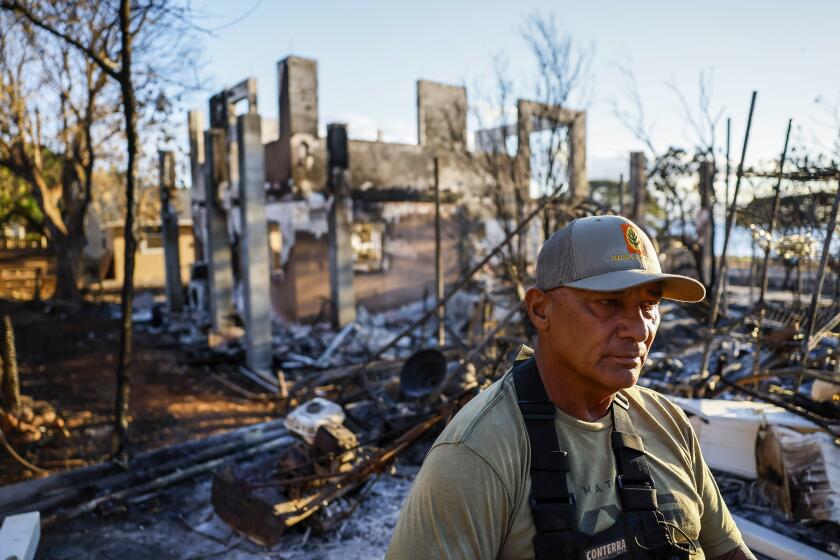
- Share via
LAHAINA, Hawaii — One of the most important members of the Los Angeles County Fire Department’s search team on Maui is struggling with his boots.
They’re new, obviously uncomfortable and making him walk funny. He keeps trying to kick them off, so his handler has tried everything, including duct tape and rubber bands, to hold them in place and help him focus on the vitally important job in front of him.
Prentiss, a 9-year-old Labrador retriever, is one of about 40 cadaver dogs doing the grueling work of searching through the rubble of Lahaina, sniffing for even the slightest trace of the more than 800 people still missing after the most lethal U.S. wildfire in a century.
Human searchers have little hope of detecting the tiny fragments that remain of many victims, each of them somebody’s mom, dad, daughter or son.
So the last hope for this paradisiacal island to find closure, for proper grieving and healing, rests with man’s best friend.

That’s a lot of pressure, and the obstacles are almost as enormous as the responsibility.
First, it’s brutally hot; the tropical sun beats down on Prentiss’ thick, dark fur without remorse. The same goes for the other three dogs here with the L.A. County search-and-rescue team, all of whom happen to be black Labs.
The dogs work in tag teams. Each can go only 15 to 20 minutes in the heat before they have to let their partner take over and retreat to the team truck, where the air conditioner is running full blast.
“They don’t get tired, they get hot,” said firefighter Nick Bartel, one of the handlers.
Then there’s the blistering pavement. The fire transformed most sources of shade — bushes, trees, buildings — to ash, so there’s little escape from the glaring sun.
In the afternoon, the asphalt can exceed 150 degrees, Bartel said.
That’s why the boots must stay on.
Trouble is, most of the footwear made for dogs isn’t really designed for scouring scorched earth after a catastrophe. They’re “booties” meant for “nice leisurely walks,” Bartel said.
“We’re putting them to the test and blowing through them pretty quickly,” Bartel said.

That’s where the duct tape comes in, lots of it. Since the booties cover only the paws, the handlers have to wrap the tape higher and higher up the dogs’ legs. They need the extra protection because the piles of ash can be several feet deep, and sometimes all that’s left of multi-story buildings after the 1,000-degree fire roared through.
When the dogs plunge into those ash piles, they can land on buried, still blazing embers.
But these dogs, almost all of whom were selected from high-energy hunting breeds and have off-the-charts prey drive, don’t let pain stop them. Sometimes they don’t even yelp.
“They just want to work, and it’s not until you get them back to the truck that you realize they’re injured,” Bartel said.
The long, hot days and danger are worth it when the dogs detect someone, said firefighter Eddie Ruiz, another handler.
His dog, Harper, was the first on the L.A. team to make a find: a 4-inch fragment of bone buried in the charred maze of a junkyard. A group of homeless people had sought shelter there, Ruiz said.
A terrifying end to a hard life.
Jowel and Relyn Delfin have taken 13 relatives into their central Maui home.
Harper, a 7-year-old female who greets strangers with soft brown eyes and a wagging tail, knows something about hard life and unpredictable twists of fate.
Her journey to the western shore of Maui started about three years ago in South Dakota when police raided a house packed with more than 20 neglected dogs, Ruiz said.
She must have impressed those first rescuers with her energy and intelligence because, instead of winding up at a kennel waiting for adoption, she made her way through the shelter system and eventually wound up halfway across the country, in Santa Paula, at a highly selective search-dog training program.
At about 4 years old, she was already long in the tooth for the demanding course, competing against much younger pups, but few could match her energy and determination.
“She’s all go and no brake,” Bartel said.
That training program is where she met her current work partner, Six. He was the last in a litter from a breeder who, not the sentimental type, named the puppies 1, 2, 3, 4, 5 and 6, tattooing the numerals on the inside of each dog’s ear.
Six wasn’t only small for a Lab; he has a leaky heart valve, lowering his value and turning him into a castaway. But somehow, he, too, impressed enough people along the way to land a spot in the training school.

Four years younger than Harper and significantly more agile, Six handles the most athletic tasks for the duo, like leaping onto high walls. The heart issue has not slowed him. “He has just been a monster,” Bartel said, like a proud dad. “An absolute little monster who loves his job.”
When they’re not shouldering the enormous responsibility of their day jobs — it’s no exaggeration to say the eyes of the world are on them now — the dogs live with their handlers and hang out with their families, just like unemployed dogs. Harper goes on vacation with Ruiz. Six would sleep in Bartel’s bed every night if his girlfriend had her way.
But strap them into their work harnesses emblazoned with “County of Los Angeles Fire Dept.” patches, and their extraordinary abilities become obvious. After racing around a search area, sticking their noses in every crack and crevice, the dogs sit down if they find something. Then their partner is led to the same area to see if they smell it, too.
When two dogs confirm a hit, their handlers call in forensics experts waiting nearby to investigate further and address the remains.
For their handlers, the psychological terrain is almost as delicate to navigate as the rubble.
Legendary big-wave surfer Archie Kalepa has turned his home in Lahaina into a well-orchestrated supply depot for survivors of the devastating fire.
The dogs need to be at least a little hyped-up and excited to do their jobs. But the handlers have to be careful not to celebrate too much with them when they make a find. The police officers and many of the National Guard troops in the search area are from Maui, some from Lahaina. Those remains could be somebody they loved.
It’s tricky, “because the dogs are only going to work so long before they get that reward,” Bartel said.
The reward is a ball. An orange rubber chewy ball. No food is required. These are Labs, after all. Anybody who has shared their life with one will understand.
Workdays for the dogs usually start around 6 a.m., when it’s still cool, and end when it gets too hot, around 3 p.m. Everyone on the team has to undergo a thorough decontamination at quitting time. That’s for health reasons and out of respect: Human ash could be mixed in the dust that covers the dogs and handlers head to toe.

Once finished, the handlers load the dogs into the truck and head to a hotel a few miles up the coast that has opened its doors to search teams from across the country.
The work of searching charred rubble for human remains weighs heavily on all the men and women involved. There’s no escaping that. Talking it through with one another helps, but so does a tail wag and a nuzzle from a co-worker who has seen it all and rolls with it. Harper and Six become therapy dogs at the hotel, Ruiz said; they’re pretty popular.
Before the fire, that hotel, the Sheraton Maui Resort and Spa, attracted tourists from around the globe. Its chief draw was the beautiful beach that serves as its backyard. As water dogs, the Labradors are drawn to that beachfront as well. Each day after work, they drag their handlers to the shore and wind down by fetching sticks thrown into the surf.
The firefighters seemed guarded talking about that aspect of their days on Maui. There has been so much debate on social media over the ethics of tourism after the fire and the need to show respect to those enduring unspeakable loss.
But so far, nobody has objected to these most essential four-legged workers cooling off in the ocean after a hard day on the job.
More to Read
Sign up for Essential California
The most important California stories and recommendations in your inbox every morning.
You may occasionally receive promotional content from the Los Angeles Times.
















